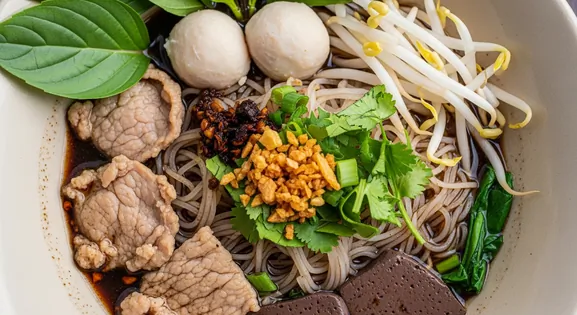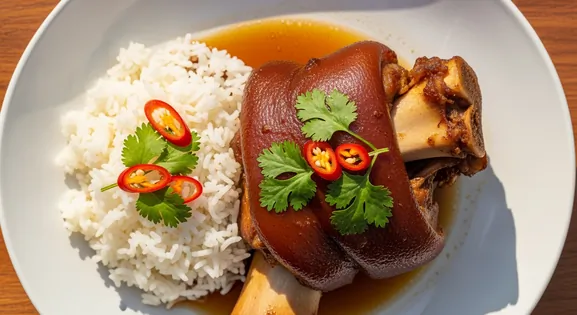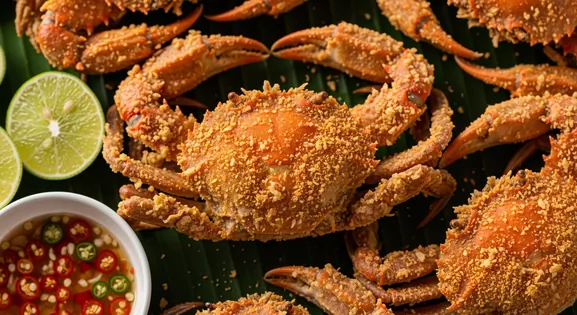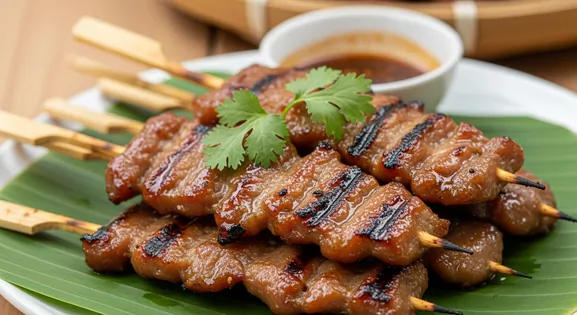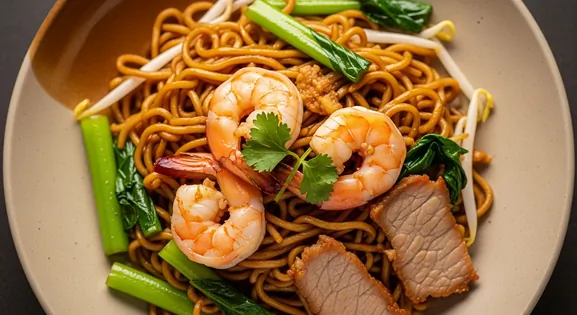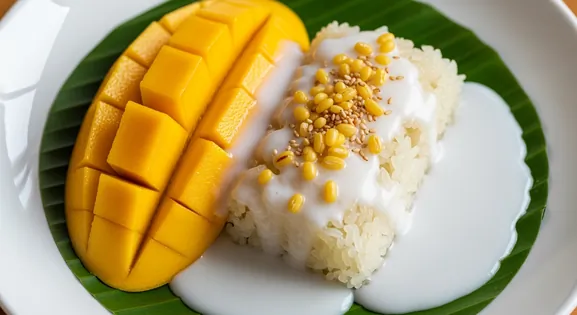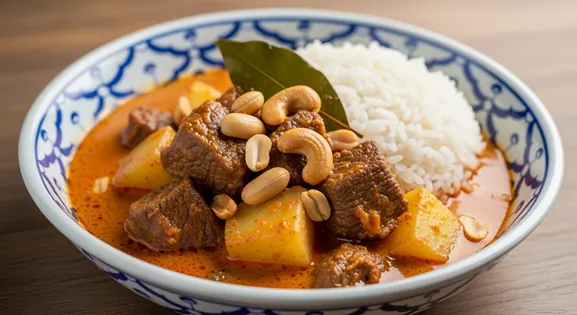Khanom Jeen in Thailand: A Complete Food Lover's Guide
ขนมจีน
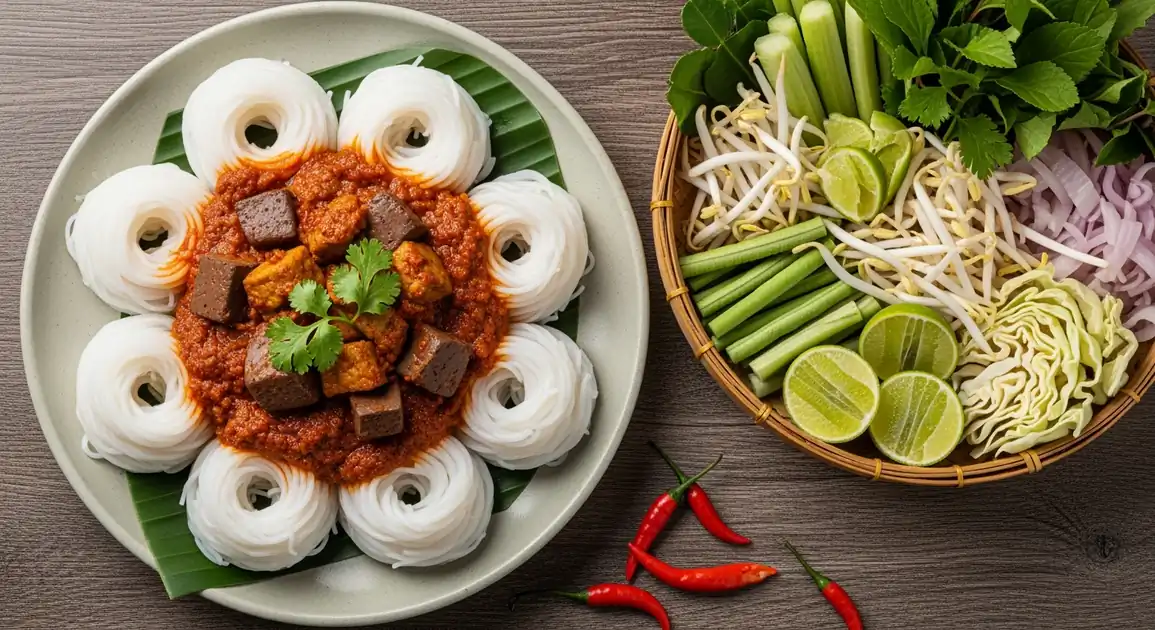
A Culinary Snapshot
Khanom Jeen is Thailand's beloved fermented rice noodle dish, distinctively served at room temperature with rich curry sauces and an abundant array of fresh vegetables and herbs. The soft, slightly tangy noodles are traditionally made through a fermentation process that creates their characteristic slippery texture and subtle flavor. Across Thailand, from Chiang Mai to Phuket, vendors serve these delicate noodles in neat coils, paired with region-specific curries ranging from spicy northern Nam Ngiaw to aromatic southern Nam Ya Tai.
From Humble Origins: A Brief History
Khanom Jeen has ancient roots in Thailand, with influences from Mon culture and possibly originating from interactions with Khmer and Chinese cuisines centuries ago. The name derives from 'kanom' (snack) and 'jin' (Chinese), suggesting its cultural connections. Traditionally, making these noodles was a communal activity in villages, with the labor-intensive process of soaking rice, fermenting the dough, and pressing the noodles through specialized equipment bringing people together. Each region developed distinctive curry sauces to accompany the noodles, reflecting local ingredients and tastes, making Khanom Jeen an edible map of Thailand's culinary diversity.
Traditional Preparation Techniques
Authentic Khanom Jeen noodles are made by soaking rice in water for several days, grinding it into a paste, fermenting the resulting dough, and then extruding the fermented rice through a special press into boiling water. This creates the characteristically soft, slightly tangy noodles. Commercial production has simplified this process, but traditional vendors still pride themselves on proper fermentation. The various curry sauces are prepared separately - typically simmering for hours with aromatics, curry pastes, and proteins. When served, the freshly made (or reheated) noodles are arranged in neat coils, with curry sauce ladled over top, and accompanied by an extensive array of fresh and pickled vegetables, herbs, and condiments.
Key Ingredients of Khanom Jeen (Fermented Rice Noodles)
Fermented Rice Noodles (Khanom Jeen)
These thin, delicate noodles are the foundation, made from fermented rice flour, giving them a unique, slightly tangy flavor and soft, slippery texture. They are typically served at room temperature.
Quality indicator: Look for noodles that are fresh, moist, and arranged in neat, distinct coils, not clumpy or dried out.
Curry Sauce (Nam Ya/Nam Ngiaw)
The heart of the dish, these rich, aromatic sauces vary regionally, from fish-based (Nam Ya) to pork and tomato (Nam Ngiaw). They provide the main flavor profile and are typically simmered for hours.
Quality indicator: A well-made sauce will be visibly simmering, have a rich color, and a complex aroma, indicating fresh ingredients and proper cooking.
Fresh Vegetables & Herbs (Phak Sod)
An essential accompaniment, providing crunch, freshness, and balancing the rich curries. Common additions include bean sprouts, long beans, pickled cabbage, basil, and various leafy greens.
Quality indicator: Vegetables should appear crisp, vibrant, and clean, indicating they are fresh and properly stored by the vendor.
Local Khanom Jeen (Fermented Rice Noodles) Variations in Thailand
Khanom Jeen Nam Ngiaw
Northern Thai specialty featuring a spicy tomato-based curry sauce with pork or beef, dried flowers, and blood cubes. Known for its distinctive reddish color and tangy, spicy flavor profile.
Khanom Jeen Nam Ya
Central Thai style with a coconut fish curry sauce, often made with snakehead fish. Creamy, aromatic, and moderately spicy with hints of kaffir lime and galangal.
Khanom Jeen Nam Ya Tai
Southern variation with an intensely spicy fish curry utilizing southern herbs and spices. Typically more fiery than its central Thai counterpart.
Khanom Jeen Nam Prik
A simpler variation with chili paste-based sauce, often less creamy and more intensely flavored with aromatics and dried chili.
Khanom Jeen Kaeng Kiao Wan
Rice noodles paired with Thai green curry, typically with chicken. Sweet, spicy, and aromatic with a vibrant green color.
Enhancing the Flavor: Classic Pairings
Fresh Herbs and Vegetables
condiment
Khanom Jeen is always served with a generous platter of fresh and pickled vegetables like bean sprouts, long beans, basil, and pickled mustard greens. These add crucial crunch, freshness, and a balancing counterpoint to the rich, often spicy, curry sauces.`
Condiments (Prik Pon, Nam Pla Prik)
flavor enhancer
Diners customize their dish with various condiments, including dried chili flakes (prik pon), fish sauce with sliced chilies (nam pla prik), lime wedges, and sugar. These allow for personal adjustment of spice, saltiness, and sourness.
Universal Quality Indicators
What to Look For
-
Noodles that appear fresh and moist, arranged in neat coils
Fresh Khanom Jeen should be slightly glossy, soft, and arranged in tidy coils. They should not look dried out, sticky, or discolored.
-
Actively simmering or steaming curry sauces
Proper temperature maintenance is crucial for quality. Curries should be kept hot (visibly steaming) to ensure optimal freshness, especially since they often contain meat and fish products.
-
Clean, organized condiment and vegetable stations
Fresh vegetables should be crisp, bright, and stored separately from raw ingredients. Look for vendors who replenish vegetables frequently and keep them covered when possible.
-
High customer turnover and local popularity
Busy stalls ensure fresh ingredients and indicate quality recognized by locals. Morning markets typically have the freshest noodles made that same day.
What to avoid
-
Noodles left uncovered for extended periods
Exposed noodles can collect dust and insects. Good vendors keep noodles covered when not actively serving.
-
Curry sauces sitting at room temperature
Sauces containing meat, fish, or coconut milk can quickly lose their quality when left at room temperature, especially in Thailand's heat.
-
Reused vegetables or condiments from previous customers
Some vendors might reuse untouched vegetables. Watch to ensure fresh vegetables are provided for each customer.
-
Dirty utensils or serving areas
Look for clean ladles, plates, and work surfaces. Unclean conditions can compromise the quality and enjoyment of your meal.
Explore Khanom Jeen (Fermented Rice Noodles) in Detail: City Guides
Discover where to find the best Khanom Jeen (Fermented Rice Noodles) and learn local tips in these cities:
Dietary Information
Dietary Information
Important Note for Travelers: Your safety is our priority. Below are the common allergens associated with the traditional preparation of this dish. However, recipes and ingredients can vary significantly between establishments. Always confirm all ingredients directly with the food vendor before ordering, especially if you have a severe allergy.
Potential Allergens
Dietary Suitability
How to Order Khanom Jeen (Fermented Rice Noodles)
Frequently Asked Questions about Khanom Jeen (Fermented Rice Noodles)
What is Khanom Jeen?
Khanom Jeen is a popular Thai dish of thin, fresh, slightly fermented rice noodles, typically served with various curry sauces and accompanied by an assortment of fresh vegetables, herbs, and sometimes pickled vegetables. The noodles themselves have a subtle tanginess from fermentation, and the dish is customizable based on regional specialties and personal preference of curry sauce.
How is Khanom Jeen different from other Thai noodles?
Khanom Jeen stands apart from other Thai noodles in several ways. First, they're made from fermented rice flour (not wheat or other grains). This fermentation gives them a unique slightly tangy flavor and soft, slippery texture. Second, they're traditionally served at room temperature or slightly warm with curry-based sauces rather than in soup. Third, Khanom Jeen is always accompanied by an extensive array of fresh vegetables and herbs for diners to customize their meal.
Is Khanom Jeen a good choice from street vendors?
Khanom Jeen can be an excellent choice from street vendors when following some basic guidelines for quality. Choose busy stalls with high turnover, ensuring fresh noodles and sauces. Look for vendors who keep noodles covered, store sauces at proper temperatures (hot sauces should be visibly steaming), and maintain clean utensils and serving areas. Fresh Khanom Jeen noodles should be slightly soft and moist, not dried out or overly sticky. Morning markets typically offer the freshest options as noodles are often made the same day.
What are the most common Khanom Jeen curry sauces?
The most common Khanom Jeen curry sauces vary by region. Northern Thailand favors 'Nam Ngiaw' (spicy tomato-based with pork/beef). Central Thailand often uses 'Nam Ya' (fish curry). Southern regions feature 'Nam Ya Tai' (spicier fish curry). Other popular options include 'Nam Prik' (chili sauce) and 'Kaeng Kiao Wan' (green curry).
Can I eat Khanom Jeen if I'm vegetarian or vegan?
Yes, vegetarian and vegan versions are possible, but specify your needs. While rice noodles are plant-based, traditional curries often contain fish sauce or shrimp paste. Ask for 'mangsawirat' (vegetarian) options. Some vendors offer plant-based sauces or plain noodles with vegetable toppings. In tourist areas, more vendors understand vegetarian requests.
What time of day is best to eat Khanom Jeen in Thailand?
Khanom Jeen is traditionally a morning to mid-day dish in Thailand. The best time to find the freshest Khanom Jeen is early morning (6 AM - 9 AM) at local markets when noodles are freshly made. Many vendors sell out by mid-day. In Northern Thailand and tourist areas, you can find it throughout the day, but morning remains ideal for authenticity and freshness. Some night markets also offer it, though morning markets generally have more variety and better quality.
Expert How-To Guides about Khanom Jeen (Fermented Rice Noodles)
How to Spot a Quality Khanom Jeen Vendor
Identify the best places to enjoy authentic, fresh, and high-quality Khanom Jeen.
- Look for busy stalls with locals lined up - high turnover means fresh food.
- Check the noodles - they should be displayed in neat coils, look moist (not dried out), and be covered when not being served.
- Observe the curry sauces - they should be actively simmering or steaming in clean pots, not sitting at room temperature.
- Survey the vegetable selection - fresh, crisp vegetables and herbs indicate overall freshness.
- Notice cleanliness - the serving area, utensils, and vendor's hands should be clean.
- Consider timing - morning markets (6 AM - 10 AM) typically offer the freshest noodles.
The Art of Eating Khanom Jeen Like a Local
Learn how to properly assemble and enjoy this customizable Thai favorite.
- Start with the noodles - take a portion of the soft rice noodles as your base.
- Select your curry sauce - ladle your preferred sauce over the noodles (don't drown them).
- Add vegetables strategically - mix some into the sauce (bean sprouts, cucumber) and keep others on the side (herbs).
- Manage spices - add dried chili flakes, fish sauce, or lime juice to taste.
- Mix thoroughly but gently - use chopsticks or fork and spoon to combine everything without breaking the noodles.
- Eat immediately - the dish is best enjoyed while the contrast between warm sauce and cool vegetables is present.
How to Choose the Right Khanom Jeen Sauce for Your Taste
Navigate the variety of curry sauces available with Khanom Jeen across Thailand.
- Assess your spice tolerance - Nam Ngiaw (northern) is moderately spicy, while southern curries like Kaeng Tai Pla are intensely hot.
- Consider flavor profiles - Fish curries (Nam Ya) are rich and aromatic, while Nam Prik is more herb-forward.
- Look at the color - Green curries are typically spicier than red or yellow options.
- Ask for a sample - many vendors will let you taste a small amount of sauce before deciding.
- Start with regional specialties - explore Northern-style Nam Ngiaw or Southern-style Nam Ya Tai.
- For first-timers, Nam Ya (central style) is often the most approachable with balanced flavors.
Our Commitment to Quality
At Tasteplorers, our mission is to provide the most accurate and useful travel information in the world. To achieve this, all content on this site is created through our unique editorial framework. We utilize leading AI research tools, guided by our proprietary prompts, and a multi-stage validation process. This entire system is overseen by our editorial team to ensure everything we publish meets our high standards for accuracy, cultural nuance, and practical value for travelers.
Learn more about our Editorial Process and our Mission.
Countries
Explore regions
Europe
Discover Europe's diverse culinary landscape, from Mediterranean flavors to hearty Alpine fare. Learn to navigate markets, decode menus, and eat like a local.
Latin America & Caribbean
Discover the vibrant cuisines of Latin America & the Caribbean. Our expert guide covers everything from Mexican street food to Peruvian ceviche and market tips.
Oceania
Explore Oceania's diverse food scene. Learn about Polynesian earth ovens, Fijian feasts, and the vibrant café culture of Australia and New Zealand.
Southeast Asia
Explore Southeast Asia's diverse food cultures from Thailand to Vietnam. Get expert tips on navigating spice levels, choosing quality vendors, and understanding the rich traditions of the region.
